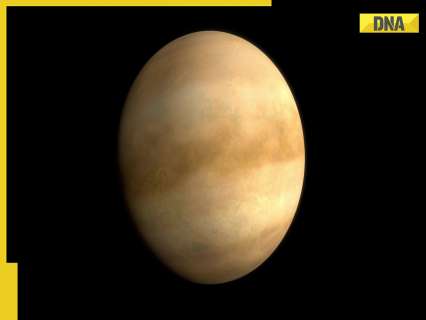The Union Cabinet has approved Rs 1,236 crore for the Venus Orbiter Mission (VOM), which is planned to launch in March 2028. This will be India’s second interplanetary mission, following the Mars Orbiter Mission, which was launched on November 5, 2013, and successfully entered Mars' orbit on September 24, 2014. Key Features of the Mission The Venus Orbiter Mission will explore Venus by studying its surface features, dust and clouds, lightning, volcanic activity, atmosphere, ionosphere, and how the planet interacts with the Sun.
Venus, the second planet from the Sun, is the hottest and brightest planet in our solar system. Ultraviolet light from the Sun energizes gases in Venus' outermost atmosphere, turning them into electrically charged particles called ions. This layer is known as the ionosphere (Earth also has an ionosphere).

The mission will also investigate why Venus, which was once thought to be similar to Earth and possibly habitable, changed over time. The mission aims to address important scientific questions and provide valuable insights. It will be carried out by the Department of Space.
Out of the total Rs 1,236 crore budget, around ₹824 crore will be used for building the spacecraft. ISRO will handle both the development and launch of the spacecraft. The project will be managed and monitored using ISRO's well-established procedures.
The spacecraft and launch vehicle will be developed in collaboration with various industries, generating numerous job opportunities and resulting in technological advancements that could benefit other sectors of the economy. This means that the innovations from the mission could be applied to other industries, driving improvements and growth in those areas. The data collected from the mission will be shared with the scientific community using the current systems in place.
The mission will prepare India for future planetary missions with bigger payloads and more efficient ways to enter orbit. 1. A Day on Venus: A Strange Experience Spending a day on Venus would be very disorienting—assuming your spacecraft or suit could handle the scorching temperatures of around 900°F (475°C).
For starters, a “day” on Venus lasts 243 Earth days, which is even longer than its year, as it takes only 225 Earth days to orbit the Sun. Additionally, due to Venus' slow rotation, the time from sunrise to sunset would be 117 Earth days. And here's a twist: the Sun would rise in the west and set in the east because Venus spins in the opposite direction to Earth.
2. Venus is hotter than Mercury, even though it’s farther from the Sun Venus has an average temperature of 475°C. This extreme heat is due to the large amount of carbon dioxide in its atmosphere, which creates a strong greenhouse effect.
The atmosphere traps heat like a blanket, making Venus much hotter than its distance from the Sun would suggest. 3. Venus spins in the opposite direction to most planets While most planets in the Solar System spin counterclockwise on their axis and orbit the Sun in the same anti-clockwise direction, Venus is different.
It orbits the Sun counterclockwise but spins clockwise on its axis. One theory for this unusual rotation is that Venus might have been knocked off its original position long ago. The only other planet that spins clockwise is Uranus.
Astronomers think that a collision with another celestial object may have knocked Venus so far off its original position that it now upside down. Similarly, Uranus spins on its side, likely caused by another early collision in its history. 4.
Venus is the second brightest object in the night sky after the Moon Venus appears very bright because its thick clouds of sulfuric acid reflect a lot of sunlight, hiding its surface from view. Its brightness is so intense that you can sometimes spot it during the day if the sky is clear and you know where to look. 5.
Venus has 90 times the atmospheric pressure of Earth The pressure on Venus is about 90 times stronger than on Earth, which is similar to the pressure you'd experience 1 km deep in the ocean. 6. Venus is named after the Roman goddess of love and beauty Venus is believed to be named after the Roman goddess of love and beauty (the equivalent of the Greek goddess Aphrodite) because of its bright, shining appearance in the sky.
Out of the five planets known to ancient astronomers, Venus was the brightest. 7. Potential for Life in Venus' Upper Atmosphere About 30 miles (50 kilometers) above Venus' surface, temperatures range from 86 to 158°F (30 to 70°C), which could support Earth-like life forms, such as "extremophile" microbes (Organisms that survive in extreme conditions).
The atmospheric pressure at this altitude is also similar to that on Earth's surface. 8. Key Facts About Venus Venus is located 67 million miles (108 million kilometers) from the Sun and has no moons.
The planet's surface reaches scorching temperatures of about 900°F (480°C), and it has a diameter of 7,520 miles (12,100 kilometers). Its atmosphere is primarily made up of 96% carbon dioxide and 3% nitrogen. 9.
Volcanoes and Plains on Venus’ Surface About two-thirds of Venus' surface is made up of flat, smooth plains, scattered with thousands of volcanoes. Some of these volcanoes, ranging in size from 0.5 to 150 miles (0.
8 to 240 km) wide, are still active today. Lava from these volcanoes has formed long, winding channels (twisting, curving paths), some stretching over 3,000 miles (5,000 km). 10.
Mountainous Terrain on Venus' Surface Around one-third of Venus' surface is made up of six mountainous regions. The largest mountain range, known as Maxwell, stretches about 540 miles (870 km) and rises up to 7 miles (11.3 km), making it the tallest feature on the planet.
11. Similar Surface Gravity Between Venus and Earth Explained Since Venus and Earth are nearly the same size and have similar mass, the surface gravity on Venus is very close to that on Earth. In fact, Venus' gravity is about 91% of Earth's.
This means if you weigh 100 pounds (45 kg) on Earth, you would weigh 91 pounds (41 kg) on Venus. Previous Missions to Venus i) Venus was the first planet ever visited by a spacecraft. NASA’s Mariner 2 flew past it and studied its thick clouds on December 14, 1962.
ii) Since then, many spacecraft from the US and other space agencies have studied Venus. One of them was NASA’s Magellan, which used radar to map the planet’s surface. iii) Soviet spacecraft were the most successful in landing on Venus, but they couldn’t last long because of the intense heat and heavy pressure on the planet's surface.
iv) More recent missions to Venus include the European Space Agency’s Venus Express, which orbited the planet from 2006 to 2016, and Japan’s Akatsuki Venus Climate Orbiter, which has been in orbit since 2016. v) NASA’s Parker Solar Probe has flown past Venus several times. Future Missions to Explore Venus a) VERITAS, short for Venus Emissivity, Radio Science, InSAR, Topography, and Spectroscopy, will be NASA's first mission to Venus since the 1990s (There has been no dedicated spacecraft from NASA to Venus since 1990).
It’s set to launch no sooner than December 2027. The spacecraft will orbit Venus and collect data to help scientists understand why Venus and Earth developed so differently, and why Venus, once possibly habitable, became a harsh and unlivable world. b) NASA plans to launch the DAVINCI+ mission (Deep Atmosphere Venus Investigation of Noble gases, Chemistry, and Imaging Plus) in the late 2020s ( "In the late 2020s" refers to the period near the end of the 2020s decade, typically around 2027 to 2029).
The mission will first study the upper atmosphere of Venus, then send a probe down to the planet’s surface to gather more information. c) The European Space Agency (ESA) has chosen the EnVision mission to study Venus in detail. NASA is a major partner in this mission and will provide a special radar called VenSAR to capture high-resolution images of the planet’s surface.
(The author of this article is a Defence, Aerospace & Political Analyst based in Bengaluru. He is also the Director of ADD Engineering Components, India, Pvt. Ltd, a subsidiary of ADD Engineering GmbH, Germany.
You can reach him at: [email protected]) (Disclaimer: The views expressed above are the author's own and do not reflect those of DNA).




















